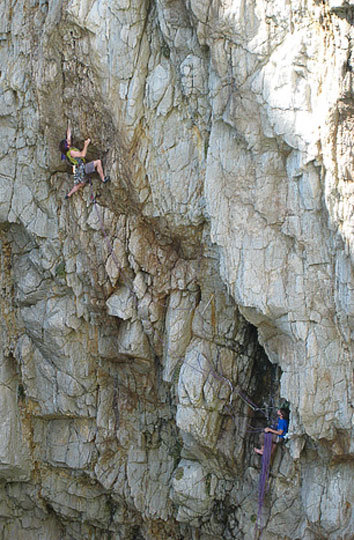
Sean Villanueva O’Driscoll on Pitch 2 of The Mad Brown (E7 6b [5.12- X], 4 pitches), Gogarth, North Wales. He and Nicolas Favresse made the second ascent of the chossy, committing line in May on their first try; though there is doubt about whether the ascent was truly an onsight, it is one of the most difficult multipitch routes ever climbed ground up in Britain. [Photo] Adam Wainwright
Invited to the BMC International Meet, Belgian climbers Nicolas Favresse and Sean Villanueva O’Driscoll climbed in Wales for the month of May 2008. The highlight of their stay was the second integral–and first ground-up onsight–ascent of The Mad Brown (E7 6b [5.12- X], 4 pitches), Gogarth, North Wales, which rises out of the sea and arches back to the sky.
The overhanging line had not seen a complete ascent since it was first opened in 1996 by Adam Wainwright and George Smith, who also had aimed to make a ground-up onsight. They eventually relied, however, on abseil inspection and four days of work to piece the route together. Until this year, only one other attempt–Leo Houlding’s–had been recorded. He marked his high point on Pitch 2 with a quickdraw that remains in place today.
The Belgian team first caught glimpse of the route when climbing with local Nick Bullock on the back wall of Wen Zawn. Strangely inspired by the loose rock on routes such as Mr. Softy (E6 6b) and Conan the Librarian (E6), they decided to try The Mad Brown–characterized by loose flakes Favresse described as “overhanging cheese”–a few days later.
The line trends left, up the right side of a large grotto, then follows an imaginary pathway through questionable vertical and horizontal flakes. To help them stay on-route, first ascensionist Wainwright hung on a rope and shouted directions. Favresse described the route as sustained but varied: Pitches 1 and 3, which he led, were particularly chossy, while Pitch 2, led by O’Driscoll, was not as loose but more technical. Favresse linked the original fourth pitch with the third.

Favresse pulls through the final pitch of The Mad Brown. [Photo] Adam Wainwright
The Belgians carried two full racks of cams and nuts to place as much gear as possible, knowing the poor rock would offer suspect protection throughout. Due to the proximity of the ocean, the carabiners left by Leo Houlding in the pitons of the first anchor could not be removed. The Belgians, therefore, were forced to trust their lives to that rusting anchor. The second anchor was no better: two old, rusty ice pins pounded into mud.
“The hardest part of the climb,” Favresse said, “was all the body tension required to try out so many holds to see which were not going to break.” Beyond the rock quality, the pair were drawn to The Mad Brown’s other adventurous side–the only way off the route is either to climb up or swim out.